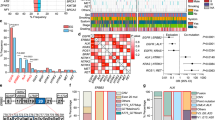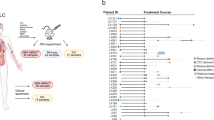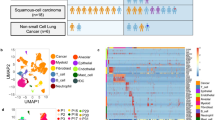Abstract
Aim:
To establish and characterize primary lung cancer cell lines from Chinese population.
Methods:
Lung cancer specimens or pleural effusions were collected from Chinese lung cancer patients and cultured in vitro with ACL4 medium (for non-small cell lung carcinomas (NSCLC)) or HITES medium (for small cell lung carcinomas (SCLC)) supplemented with 5% FBS. All cell lines were maintained in culture for more than 25 passages. Most of these cell lines were further analyzed for oncogenic mutations, karyotype, cell growth kinetics, and tumorigenicity in nude mice.
Results:
Eight primary cell lines from Chinese lung cancer patients were established and characterized, including seven NSCLC cell lines and one SCLC cell line. Five NSCLC cell lines were found to harbor epidermal growth factor receptor (EGFR) kinase domain mutations.
Conclusion:
These well-characterized primary lung cancer cell lines from Chinese population provide a unique platform for future studies of the ethnic differences in lung cancer biology and drug response.
Similar content being viewed by others
Log in or create a free account to read this content
Gain free access to this article, as well as selected content from this journal and more on nature.com
or
References
Jemal A, Siegel R, Ward E, Hao Y, Xu J, Thun MJ . Cancer statistics, 2009. CA Cancer J Clin 2009; 59: 225–49.
Jemal A, Siegel R, Xu J, Ward E . Cancer statistics, 2010. CA Cancer J Clin 2010; 60: 277–300.
Gazdar AF, Girard L, Lockwood WW, Lam WL, Minna JD . Lung cancer cell lines as tools for biomedical discovery and research. J Natl Cancer Inst 2010; 102: 1310–21.
Masters JR . HeLa cells 50 years on: the good, the bad and the ugly. Nat Rev Cancer 2002; 2: 315–9.
Lieber M, Smith B, Szakal A, Nelson-Rees W, Todaro G . A continuous tumor-cell line from a human lung carcinoma with properties of type II alveolar epithelial cells. Int J Cancer 1976; 17: 62–70.
Masuda N, Fukuoka M, Takada M, Kudoh S, Kusunoki Y . Establishment and characterization of 20 human non-small cell lung cancer cell lines in a serum-free defined medium (ACL-4). Chest 1991; 100: 429–38.
Loh PM, Clamon GH, Robinson RA, White ML, Hukku B, Rossi NP, et al. Establishment and characterization of four new human non-small cell lung cancer cell lines. Cancer Res 1984; 44: 3561–9.
Anger B, Bockman R, Andreeff M, Erlandson R, Jhanwar S, Kameya T, et al. Characterization of two newly established human cell lines from patients with large-cell anaplastic lung carcinoma. Cancer 1982; 50: 1518–29.
Baillie-Johnson H, Twentyman PR, Fox NE, Walls GA, Workman P, Watson JV, et al. Establishment and characterisation of cell lines from patients with lung cancer (predominantly small cell carcinoma). Br J Cancer 1985; 52: 495–504.
Carney DN, Gazdar AF, Bepler G, Guccion JG, Marangos PJ, Moody TW, et al. Establishment and identification of small cell lung cancer cell lines having classic and variant features. Cancer Res 1985; 45: 2913–23.
Simms E, Gazdar AF, Abrams PG, Minna JD . Growth of human small cell (oat cell) carcinoma of the lung in serum-free growth factor-supplemented medium. Cancer Res 1980; 40: 4356–63.
Oie HK, Russell EK, Carney DN, Gazdar AF . Cell culture methods for the establishment of the NCI series of lung cancer cell lines. J Cell Biochem Suppl 1996; 24: 24–31.
Gazdar AF, Gao B, Minna JD . Lung cancer cell lines: Useless artifacts or invaluable tools for medical science? Lung Cancer 2010; 68: 309–18.
Jang TW, Oak CH, Chang HK, Suo SJ, Jung MH . EGFR and KRAS mutations in patients with adenocarcinoma of the lung. Korean J Intern Med 2009; 24: 48–54.
Pao W, Miller VA . Epidermal growth factor receptor mutations, small-molecule kinase inhibitors, and non-small-cell lung cancer: current knowledge and future directions. J Clin Oncol 2005; 23: 2556–68.
Riely GJ, Marks J, Pao W . KRAS mutations in non-small cell lung cancer. Proc Am Thorac Soc 2009; 6: 201–5.
Sun YH, Fang R, Gao B, Han XK, Zhang JH, Pao W, et al. Comparable rate of EGFR kinase domain mutation in lung adenocarcinomas from Chinese male and female never-smokers. Acta Pharmacol Sin 2010; 31: 647–8.
Gao B, Sun Y, Zhang J, Ren Y, Fang R, Han X, et al. Spectrum of LKB1, EGFR, and KRAS mutations in chinese lung adenocarcinomas. J Thorac Oncol 2010; 5: 1130–5.
Phan VH, Moore MM, McLachlan AJ, Piquette-Miller M, Xu H, Clarke SJ . Ethnic differences in drug metabolism and toxicity from chemotherapy. Expert Opin Drug Metab Toxicol 2009; 5: 243–57.
Sekine I, Yamamoto N, Nishio K, Saijo N . Emerging ethnic differences in lung cancer therapy. Br J Cancer 2008; 99: 1757–62.
Sun Y, Ren Y, Fang Z, Li C, Fang R, Gao B, et al. Lung adenocarcinoma from east asian never smokers is a disease largely defined by targetable oncogenic mutant kinases. J Clin Oncol 2010; 28: 4616–20.
Haber DA, Bell DW, Sordella R, Kwak EL, Godin-Heymann N, Sharma SV, et al. Molecular targeted therapy of lung cancer: EGFR mutations and response to EGFR inhibitors. Cold Spring Harb Symp Quant Biol 2005; 70: 419–26.
Yang CH . EGFR tyrosine kinase inhibitors for the treatment of NSCLC in East Asia: present and future. Lung Cancer 2008; 60: S23–30.
Gazdar AF, Oie HK . Cell culture methods for human lung cancer. Cancer Genet Cytogenet 1986; 19: 5–10.
Brower M, Carney DN, Oie HK, Gazdar AF, Minna JD . Growth of cell lines and clinical specimens of human non-small cell lung cancer in a serum-free defined medium. Cancer Res 1986; 46: 798–806.
Cappuzzo F, Hirsch FR, Rossi E, Bartolini S, Ceresoli GL, Bemis L, et al. Epidermal growth factor receptor gene and protein and gefitinib sensitivity in non-small-cell lung cancer. J Natl Cancer Inst 2005; 97: 643–55.
Ali S, Banerjee S, Schaffert JM, El-Rayes BF, Philip PA, Sarkar FH . Concurrent inhibition of NF-kappaB, cyclooxygenase-2, and epidermal growth factor receptor leads to greater anti-tumor activity in pancreatic cancer. J Cell Biochem 2010; 110: 171–81.
Sugaya M, Takenoyama M, Osaki T, Yasuda M, Nagashima A, Sugio K, et al. Establishment of 15 cancer cell lines from patients with lung cancer and the potential tools for immunotherapy. Chest 2002; 122: 282–8.
NCI-Navy Medical Oncology Branch cell line supplement. J Cell Biochem Suppl 1996; 24: 1–291.
Girard L, Zochbauer-Muller S, Virmani AK, Gazdar AF, Minna JD . Genome-wide allelotyping of lung cancer identifies new regions of allelic loss, differences between small cell lung cancer and non-small cell lung cancer, and loci clustering. Cancer Res 2000; 60: 4894–906.
Lam DC, Girard L, Suen WS, Chung LP, Tin VP, Lam WK, et al. Establishment and expression profiling of new lung cancer cell lines from Chinese smokers and lifetime never-smokers. J Thorac Oncol 2006; 1: 932–42.
Nagai Y, Miyazawa H, Huqun, Tanaka T, Udagawa K, Kato M, et al. Genetic heterogeneity of the epidermal growth factor receptor in non-small cell lung cancer cell lines revealed by a rapid and sensitive detection system, the peptide nucleic acid-locked nucleic acid PCR clamp. Cancer Res 2005; 65: 7276–82.
Noro R, Gemma A, Kosaihira S, Kokubo Y, Chen M, Seike M, et al. Gefitinib (IRESSA) sensitive lung cancer cell lines show phosphorylation of Akt without ligand stimulation. BMC Cancer 2006; 6: 277.
Kubo T, Yamamoto H, Lockwood WW, Valencia I, Soh J, Peyton M, et al. MET gene amplification or EGFR mutation activate MET in lung cancers untreated with EGFR tyrosine kinase inhibitors. Int J Cancer 2009; 124: 1778–84.
Shigematsu H, Takahashi T, Nomura M, Majmudar K, Suzuki M, Lee H, et al. Somatic mutations of the HER2 kinase domain in lung adenocarcinomas. Cancer Res 2005; 65: 1642–6.
Shimamura T, Li D, Ji H, Haringsma HJ, Liniker E, Borgman CL, et al. Hsp90 inhibition suppresses mutant EGFR-T790M signaling and overcomes kinase inhibitor resistance. Cancer Res 2008; 68: 5827–38.
Lu Y, Liang K, Li X, Fan Z . Responses of cancer cells with wild-type or tyrosine kinase domain-mutated epidermal growth factor receptor (EGFR) to EGFR-targeted therapy are linked to downregulation of hypoxia-inducible factor-1 alpha. Mol Cancer 2007; 6: 63.
Sordella R, Bell DW, Haber DA, Settleman J . Gefitinib-sensitizing EGFR mutations in lung cancer activate anti-apoptotic pathways. Science 2004; 305: 1163–7.
Tracy S, Mukohara T, Hansen M, Meyerson M, Johnson BE, Jänne PA . Gefitinib induces apoptosis in the EGFRL858R non-small-cell lung cancer cell line H3255. Cancer Res 2004; 64: 7241–4.
Acknowledgements
This work was supported by the National Basic Research Program of China (2010CB912102), the National Natural Science Foundation of China (30871284 and 30971461), the Chinese Academy of Sciences (KSCX1-YW-22), and the Science and Technology Commission of Shanghai Municipality (08PJ14105, 09JC1416300). Hong-bin JI is a scholar of the Hundred Talents Program of the Chinese Academy of Sciences.
Author information
Authors and Affiliations
Corresponding authors
Rights and permissions
About this article
Cite this article
Zheng, C., Sun, Yh., Ye, Xl. et al. Establishment and characterization of primary lung cancer cell lines from Chinese population. Acta Pharmacol Sin 32, 385–392 (2011). https://doi.org/10.1038/aps.2010.214
Received:
Accepted:
Published:
Issue date:
DOI: https://doi.org/10.1038/aps.2010.214
Keywords
This article is cited by
-
Effects of vegetation restoration on local microclimate on the Loess Plateau
Journal of Geographical Sciences (2022)
-
Patient-Derived Cells to Guide Targeted Therapy for Advanced Lung Adenocarcinoma
Scientific Reports (2019)
-
Cell Division Cycle 42 plays a Cell type-Specific role in Lung Tumorigenesis
Scientific Reports (2017)
-
Applicability evaluation of the SWIM at river basins of the black soil region in Northeast China: A case study of the upper and middle Wuyuer River basin
Journal of Geographical Sciences (2017)
-
Regulation of EGFR nanocluster formation by ionic protein-lipid interaction
Cell Research (2014)



